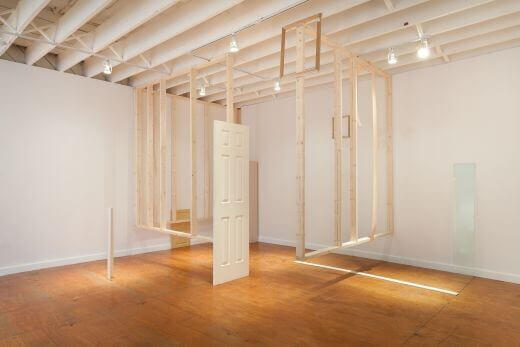Leyden Rodriguez-Casanova: Intimate Material Systems
Janet Batet

Installation view: Leyden Rodriguez-Casanova: Intimate Material Systems, Alejandra von Hartz Gallery, 2015
April 9–June 7, 2015
Intimate Material Systems, a solo show by Miami artist Leyden Rodriguez-Casanova, features a large-scale installation bordered by several recent wall and floor works that, as an ensemble, speak to a characteristic, painstaking inquiry about art, economics, and spirituality consistently present in the artist’s output. Based on the principle of “cultural passivity” articulated by Theodor Adorno and Max Horkheimer’s Dialectic of Enlightenment, Rodriguez-Casanova appropriates mass-produced construction materials, anonymous and deprived of any subjectivity, and turns them into works of art. Drywall, PVC shutters, screens, metal window frames, tiles, doors, and wooden structures become not only the physical materials that serve as starting point, but the essential conceptual fiber of the new pieces, entities in which economical and cultural existence fully reverberate.
Placed at the core of the gallery, A Divided Structural Composition is a site-specific installation that leverages the architectural features of the space, working at once as a unifying object that turns the two gallery spaces into a single room, incorporating the existing architectural partition as an active, meaningful component of the piece.
Playing with the legacy of minimalism, as in the use of serialized elements and industrial materials, the installation reflects attentively on art history and suburban architecture as it questions notions of the so-called “noble” or traditional materials and their direct correlation to art’s market value. The artist previously and masterfully addressed this concern in another recent piece: Round Faux Marble (2014, exhibited as part of the group show New Dialogues at Alejandra von Hartz last summer). In play with the minimalist tradition of neutrality that relinquishes the subjective component of materials, and looking as well at the Renaissance’s Tondo Doni widespread portraiture format associated with domestic values, this stunning piece is the perfect portrait of contemporary family, in contrast to those of the Holy Family. The 41.5-inch round work respects the conventional proportions of the Tondo Doni (at least 24 inches), but in making an effective use of the trompe-l’oeil, the expected fine art materials have been substituted by industrial ones (vinyl, wood, steel), establishing a touching metaphor about family, spirituality, and economic contingency in the contemporary world.
Addressing the elements of architecture within the space and reasserting the use of the color white, A Divided Structural Composition maintains the artist’s approach and understanding of suburban depersonalization. The work offers a wink toward the white cube as ideological space, and exposes the ensuing risk of the symbolic charge inherent in the artwork becoming trivial.
With minimal intervention, Rodriguez-Casanova manages to provide these rough and neutral materials with a crucial evocative power. Suddenly, we discover ourselves at the other side of the mirror, behind the scene where any subterfuge can be disarticulated. We then gain access not to the house, but to home.
Beyond the central installation, the Wall Unfinished Work series presents three pieces that hold significant interplay with the tradition of geometric abstraction. Rodriguez-Casanova creates a sort of geometric brutalism that, far from hiding the structure or trying to embellish the everyday, common materials, dignifies and elevates these mass-produced resources to the status of art.










